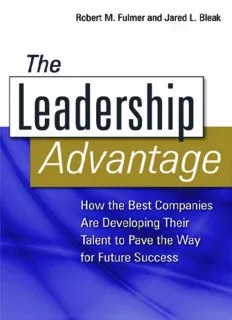
The Leadership Advantage: How the Best Companies Are Developing Their Talent to Pave the Way for Future Success PDF
Preview The Leadership Advantage: How the Best Companies Are Developing Their Talent to Pave the Way for Future Success
The Leadership Advantage .................16497$ $$FM 08-08-0710:02:56 PS PAGEi This page intentionally left blank .................16497$ $$FM 08-08-0710:02:56 PS PAGEii The Leadership Advantage How the Best Companies Are Developing Their Talent to Pave the Way for Future Success Robert M. Fulmer Jared L. Bleak American Management Association New York • Atlanta • Brussels • Chicago • Mexico City • San Francisco Shanghai • Tokyo • Toronto • Washington,D.C. .................16497$ $$FM 08-08-0710:02:56 PS PAGEiii SpecialdiscountsonbulkquantitiesofAMACOMbooksare availabletocorporations,professionalassociations,andother organizations.Fordetails,contactSpecialSalesDepartment, AMACOM,adivisionofAmericanManagementAssociation, 1601Broadway,NewYork,NY10019. Tel:212-903-8316.Fax:212-903-8083. E-mail:[email protected] Website:www.amacombooks.org/go/specialsales ToviewallAMACOMtitlesgoto:www.amacombooks.org Thispublicationisdesignedtoprovideaccurateandauthoritative informationinregardtothesubjectmattercovered.Itissoldwith theunderstandingthatthepublisherisnotengagedinrendering legal,accounting,orotherprofessionalservice.Iflegaladviceor otherexpertassistanceisrequired,theservicesofacompetent professionalpersonshouldbesought. LibraryofCongressCataloging-in-PublicationData Fulmer,RobertM. Theleadershipadvantage:howthebestcompaniesaredevelopingtheirtalent topavethewayforfuturesuccess/RobertM.Fulmer, JaredL.Bleak. p. cm. Includesbibliographicalreferencesandindex. ISBN-13:978-0-8144-0925-1(hardcover) ISBN-10:0-8144-0925-3(hardcover) 1.Executives—Trainingof. 2. Executives—Trainingof—Casestudies. 3. Leadership. 4. Organizationallearning. 5. Successinbusiness. I. Bleak, JaredL. II. Title. HD30.4.F83 2007 658.4(cid:2)092—dc22 2007011453 (cid:2)2008RobertM.Fulmer Allrightsreserved. PrintedintheUnitedStatesofAmerica. Thispublicationmaynotbereproduced, storedinaretrievalsystem, ortransmittedinwholeorinpart, inanyformorbyanymeans,electronic, mechanical,photocopying,recording,orotherwise, withoutthepriorwrittenpermissionofAMACOM, adivisionofAmericanManagementAssociation, 1601Broadway,NewYork,NY10019. Printingnumber 10 9 8 7 6 5 4 3 2 1 .................16497$ $$FM 08-08-0710:02:57 PS PAGEiv Contents Preface vii Part I. Leadership Development as a Strategic Force Chapter1. WhatWeHaveLearnedAboutStrategicLeadership Development 3 Chapter2. MakingLeadershipDevelopmentaStrategicLever 25 Chapter3. BuildinganAlignedArchitectureforStrategic LeadershipDevelopment 45 Chapter4. ImplementingSuccessful StrategicLeadership Development 63 Chapter5. LeveragingLeadershipDevelopmentforHigh Potentials 83 Chapter6. EvaluatingSuccessinStrategicLeadership Development 103 Chapter7. What’sNext? TheFutureof StrategicHuman- CapitalManagement 123 Part II. Detailed Case Studies of Best-Practice Companies CaterpillarUniversityCollegeofLeadership 131 CiscoSystems 149 v .................16497$ CNTS 08-08-0710:03:01 PS PAGEv vi CONTENTS PepsiCoInc. 175 PricewaterhouseCoopers 197 WashingtonGroupInternational 223 Notes 247 References 251 Index 255 .................16497$ CNTS 08-08-0710:03:01 PS PAGEvi Preface Change continues to be the major constant in the competitive global business environment. The challenge of keeping up with, or leading, technology has never been more daunting. Competition is coming from new and unanticipated sources. But perhaps the most critical change facing senior executives in global organizations today is the task of preparing a new generation of leaders who will extend the strategic reach of the organizations they lead. Being ‘‘built to last’’ requiresconstant renewal.This renewalis typicallybased onleaders’ continuingtodevelopthemselvesandtheirsuccessorgeneration. Leadership and learning play a critical role in enabling organiza- tional growth and transformation. Today’s and tomorrow’s leaders must be flexible, collaborative, able to leverage subject-matter exper- tise,andwillingtocontinuelearning.Learningorganizationsmustbe abletosupportleadersastheydeveloptheaforementionedcharacter- istics. There are real opportunities for synergies between the current generation of top executives and the leaders who will succeed them. While leveraging leadership-development programs to achieve their own objectives, top executives can also contribute to the develop- ment of younger managers. By serving as teachers and role models, these top executives provide direction and insight into their strategic goals and help to ensure that the company’s leadership strategy and development programs support the strategic needs of the business, today and tomorrow. The learning organization, in turn, benefits fromgreaterinsightintoitsbusinesschallengeswhilesimultaneously vii .................16497$ PREF 08-08-0710:03:03 PS PAGEvii viii PREFACE providing increasingly targeted development programs that result in improvedorganizationalcapability. Organizational capability does not come just from a collection of talented and individually competent people but also stems from the organization’s collective ability to act as one in meeting its strategy. Therefore, closing gaps in the organization’s ability to execute its strategicinitiativesisdistinctfromclosinggapsinanindividual’scom- petency. An organizational capability focus shifts developmental pri- orities and requires coordination of initiatives (e.g., job rotations, special projects, formal training, mentoring, assessment, coaching, andactionlearning)amongpeoplewithinagroupandacrossgroups. It also recognizes that organizational capability requires developing the collective capabilities of various groups and teams within the or- ganization.Otherwaysofincreasingorganizationalcapabilityinclude the improvement of infrastructure to support the desired capability, greater alignment with strategy, the improvement of employee skills andtechnicalexpertise,andchangeintheorganizationalculture.The abilityofgroupsandteamstoworktogethereffectivelyrequiresmore than theright combinationof individualcompetencies. Itrequires its ownattentioninbuildingorganizationalcapability. TheAmericanProductivityandQualityCenter(APQC),theCenter for Creative Leadership (CCL), and Duke Corporate Education (DukeCE)joinedforcesin2006toconductabenchmarkingstudyto gain a better understanding of how to elevate the importance of the leadership-development function as a must-have for executing strat- egy(notanice-to-havefordevelopingindividuals).Theresearchteam also wanted to learn how a strategy for developing leaders and an integrated leadership-development architecture can contribute to business success. By gaining insights into the best approaches for evaluating leadership development, we hope to find ways of gaining successattheindividualandorganizationallevels. Study Scope Theobjectivesofthisstudywereto: ▲ Discover best practices in tying leadership culture, values, practices,anddevelopmenttobusinessstrategy .................16497$ PREF 08-08-0710:03:03 PS PAGEviii PREFACE ix ▲ Identify best practices for creating strategically relevant collective-learningopportunities ▲ Uncoverarchitecturesforintegrating variousdevelopmentini- tiativesformaximumimpact ▲ Understandhoworganizationsuseleadershipdevelopmentto support the execution of business strategy and how to meet long- term needs to develop individual competencies while also building immediately needed organizational capability to address business challenges Theorganizationsselectedfordeep,detailedstudythroughstruc- tured data collection and site visits (also known as best-practice part- ners) demonstrate innovative performance in one or more of the study focus areas. The goal of the project was to examine organiza- tions that excel in one or more aspects of the scope and determine the best practices from all the organizations studied. To achieve this goal, the APQC study team selected potential best-practice partners for study, based on a history of excellence and success in the scope areas. Project sponsors—organizations that sponsored the research, were interested in learning from the study’s results, and participated in site visits and formal research—selected the final list of best- practice companies from the candidates. The project sponsors also served as a comparator group to the best-practice partners by partici- pating in the survey that was administered. This comparison is made throughoutthebook. Acknowledgments We express our appreciation to the best-practice partner organiza- tions and the specific individuals from each organization who were partof thestudy,including: ▲ Caterpillar: Chris Arvin, dean, College of Leadership; Deb Conklin, succession planning manager; Kim Converse, senior learn- ing consultant; Pat Murphy, manager, succession management; Deb Nelson,senior learningconsultant; ChrisSchena,vice president,Mo- .................16497$ PREF 08-08-0710:03:04 PS PAGEix
Description: